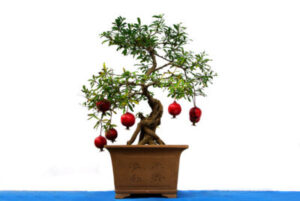Pomegranate bonsai tree

informations
Pomegranate bonsai is very appreciated for its enchanting blooms, and for its ease cultivation. The pomegranate is a plant belonging to the Punicacee family suitable for the creation of a fruit bonsai.
Exposure and temperatures: during spring, keep the pomegranate bonsai in full sun to promote flowering and development of a compact and uniform vegetation. In summer, however, you may protect the roots from the daily high temperatures, avoiding their overheating. In autumn you can safely expose it to the sun to improve the colour and flavour of the fruits. Finally, in winter you can keep pomegranate bonsai outdoor protecting its roots because of their sensitivity to frosts and low temperatures.
Soil: not acid but highly draining. Choose an universal soil mixed with sand and porous clay such as akadama.
Irrigation: irrigate abundantly when the soil is dry. You may avoid water stagnation that can cause damage to roots.
Liquid fertilizers for Pomegranate bonsai tree
You can choose between different types of liquid fertilizers depending on the needs of plants. A good fertilization strategy guarantees beautiful and healthy plants. The fertilization strategy depends on the season and physiological stages of plant. In fact, to favor the vegetative restart and during the spring you can choose the fertilizer Pro-Care NPK 12.6.6 . While in the autumn use Pro-Care NPK 3.6.9, with a lower concentration of nitrogen. Pro-Care NPK 3.6.9 promotes secondary branching, reducing the elongation of the internodes. Finally, for the flowering you can fertilize with Pro-Care NPK 4.8.16. It promotes blooms and futtifications with intense and uniform colors.
Slow-release fertilizer- Discover Mythos 5.6.5.
Mythos a slow release organic fertilizer suitable for all bonsai trees.
Mythos bonsai fertilizer (NPK 5-6-5) improves the chemical structure of the soil thanks to two exclusive production technologies:
- RyZea technology make with biologically active seaweed molecules. RyZea stimulates plant metabolism and promotes enzymatic processes.
- BPC technology a pool of rhizobacteria of the genus Bacillus (PGPR). The rhizobacteria (PGPR) are very important growth factors for plant formation in a healthy environment. In fact, these micro-organisms promote plant growth through direct and indirect mechanisms.
This organic fertilizer rich in organic substance and protein hydrolysates with variable mineralization meets the nutritional needs of hardwoods, flowering plants and fruit.
Why to use bioactivators in organic gardening
Bioactivators play a fundamental role in supporting fertilization. These substances, in fact, improve the absorption of nutrients, increase tolerance to various environmental stresses. Moreover thanks to their regular use, you can reduce the amount of fertilizer necessary to plants and obtain better performance.
Pomegranate yellow leaves?
It is very important to apply micronutrients to the soil, to avoid plant nutrient deficiencies. During fertilization, it is necessary to supplement the micronutrients to avoid deficiencies in plants. Particularly, if the plant will look unhealthy ( for example yellow leaves, holes in leaves and flowers, etc.), it could be a ferric clorosis. You can apply Ferro- UP for ferric chlorosis or Micro-One for other micronutrients deficiencies. In case of mixing with Bio Complet Plus or mineral fertilizer, it is necessary to halve the doses indicated on the label and apply only in fertigation. Repeat the treatment every 10 days for about a month.
Bonsai pomegranate care
Red spider, cochineal, and aphids can attack your bonsai! To prevent the damnage and improve plant resictance use of resistance inductors. In particular, cochineal attacks can be discouraged with the use of Even Green. While Full Bio to prevent and discourage the attack of all phytophagous insects, such as the red spider and aphids. Resistance inductors, therefore, are green alternative solutions to the classic insecticides ideal for bonsai care.
Propagation by cutting and layering
Reproduce your bonsai by grafting or layering. The ideal period is in winter, in January, when the plant is in full vegetative rest and then try to trigger its rooting in March, with the increase in temperatures. Particularly for propagation by grafting or layering, Doctor Bioges recommends the use of Radikal Sprinter.
Regular maintenance pruning is necessary to retain the bonsai’s shape. Maintenance pruning is carried out to eliminate the excessive growths and the crossings between the branches that have formed and developed throughout the year. Particularly, the maintenance pruning to maintain and refine the shape of a pomegranate bonsai tree, can be done during the early spring or mid-autumn. After pruning apply propolis to avoid fungal diseases.
Pomegranate bonsai repotting
Repot the plant during the spring and every two years using bonsai soil mixture. After repotting, apply a root stimulator. Particulary, Doctor Bioges recommends to use Radikal Sprinter made with amino acids and vitamins (such as tryptophan). The root supplement, in fact, prolongs the vitality of the root system. In addiction, it can be mixed with mycorrhizae, such as Neo-ryza and Mico-Green. Finally, it will be resistant to various forms of stress. Its effects, therefore, are visible from the first treatment.
